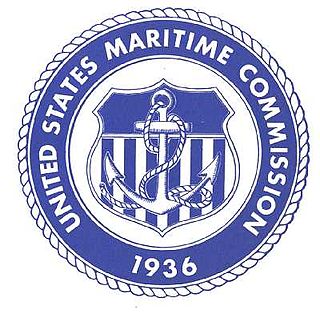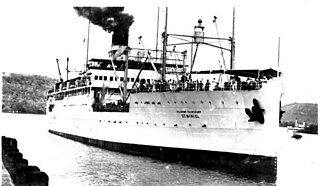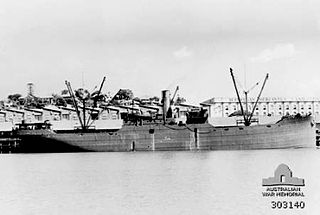SS City of Flint, a Hog Islander freighter built by American International Shipbuilding at the Hog Island Shipyard, Philadelphia for the United States Shipping Board (USSB), Emergency Fleet Corporation. City of Flint was named to honor the citizens of Flint, Michigan for their effort in Liberty Loan drives during World War I.

The United States Shipping Board (USSB) was established as an emergency agency by the 1916 Shipping Act, on September 7, 1916. The United States Shipping Board's task was to increase the number of US ships supporting the World War I efforts. United States Shipping Board program ended on March 2, 1934.

The United States Maritime Commission (MARCOM) was an independent executive agency of the U.S. federal government that was created by the Merchant Marine Act of 1936, which was passed by Congress on June 29, 1936, and was abolished on May 24, 1950. The commission replaced the United States Shipping Board which had existed since World War I. It was intended to formulate a merchant shipbuilding program to design and build five hundred modern merchant cargo ships to replace the World War I vintage vessels that comprised the bulk of the United States Merchant Marine, and to administer a subsidy system authorized by the Act to offset the cost differential between building in the U.S. and operating ships under the American flag. It also formed the United States Maritime Service for the training of seagoing ship's officers to man the new fleet.
SS Cotopaxi was an Emergency Fleet Corporation (EFC) Design 1060 bulk carrier built for the United States Shipping Board (USSB) under the World War I emergency shipbuilding program. The ship, launched 15 November 1918, was named after the Cotopaxi stratovolcano of Ecuador. The ship arrived in Boston, 22 December 1918, to begin operations for the USSB, through 23 December 1919, when Cotopaxi was delivered to the Clinchfield Navigation Company under terms of sale.

USS Leonard Wood (APA-12) was built by Bethlehem Shipbuilding Corporation and launched 17 September 1921 at Sparrows Point, Maryland as Nutmeg State, an Emergency Fleet Corporation Design 1029 ship intended as a World War I troop transport, but redesigned upon the armistice as a passenger and cargo ship and completed as Western World for delivery to the United States Shipping Board. The ship's acceptance on 5 May 1922 and delivery on 9 May 1922 marked the completion of the wartime shipbuilding program of the Emergency Fleet Corporation and the Shipping Board.

St. Mihiel was a troopship built for the United States Shipping Board by the American International Shipbuilding Corporation at Hog Island, Pennsylvania. The ship was operated from 1922 until mid-1940 as USAT St. Mihiel by the Army Transport Service. In July 1941 the ship was transferred to the Navy which commissioned her USS St. Mihiel with the hull number AP-32. In November 1943, she was transferred back to the Army and converted into the hospital ship, USAHS St. Mihiel.
SS Managua was a Nicaraguan Cargo ship that the German submarine U-67 torpedoed on 16 June 1942 in the Straits of Florida while she was travelling from Charleston, South Carolina, United States to Havana, Cuba with a cargo of Potash. The ship was built as Glorieta, a Design 1049 ship in 1919, operated by the United States Shipping Board (USSB) until sold to the Munson Steamship Line in 1920 and renamed Munisla. The ship was sold foreign to a Honduran company, Garcia, in 1937 and renamed Neptuno. In 1941 the ship was re-flagged in Nicaragua with the name Managua.

The Design 1023 ship was a steel-hulled cargo ship design approved for mass production by the United States Shipping Board's (USSB) Emergency Fleet Corporation (EFC) in World War I. Like many of the early designs approved by the EFC, the Design 1023 did not originate with the EFC itself but was based on an existing cargo ship designed by Theodore E. Ferris for the United States Shipping Board (USSB). The ships, to be built by the Submarine Boat Corporation of Newark, New Jersey, were the first to be constructed under a standardized production system worked out by Ferris and approved by the USSB.
SSCapillo was a Design 1022 cargo ship built for the United States Shipping Board immediately after World War I.
Suremico was a Design 1023 cargo ship built for the United States Shipping Board (USSB) immediately after World War I. She was later named the Nisqually and converted into a barge and later a scow. She was bombed and sunk during the Battle of Wake Island.
SSNew England was a Design 1023 cargo ship built for the United States Shipping Board immediately after World War I.
SSSuedco was a Design 1023 cargo ship built for the United States Shipping Board immediately after World War I.
SSSuboatco was a Design 1023 cargo ship built for the United States Shipping Board immediately after World War I.
SSSuportco was a Design 1023 cargo ship built for the United States Shipping Board immediately after World War I.
SSCambridge was a Design 1023 cargo ship built for the United States Shipping Board immediately after World War I.
SSKehuku was a Design 1031 tanker ship built for the United States Shipping Board immediately after World War I.
SSMary was a Design 1022 cargo ship built for the United States Shipping Board immediately after World War I.
SSCassimir was a Design 1022 cargo ship built for the United States Shipping Board immediately after World War I.
SSCarrabulle was a Design 1022 cargo ship built for the United States Shipping Board immediately after World War I.
SSComol Cuba was a Design 1022 cargo ship built for the United States Shipping Board immediately after World War I. Converted to a tanker, she spent most of her career transporting molasses, a byproduct of sugar refining, to the United States. During World War II, she transported petroleum before returning to the private sector.




